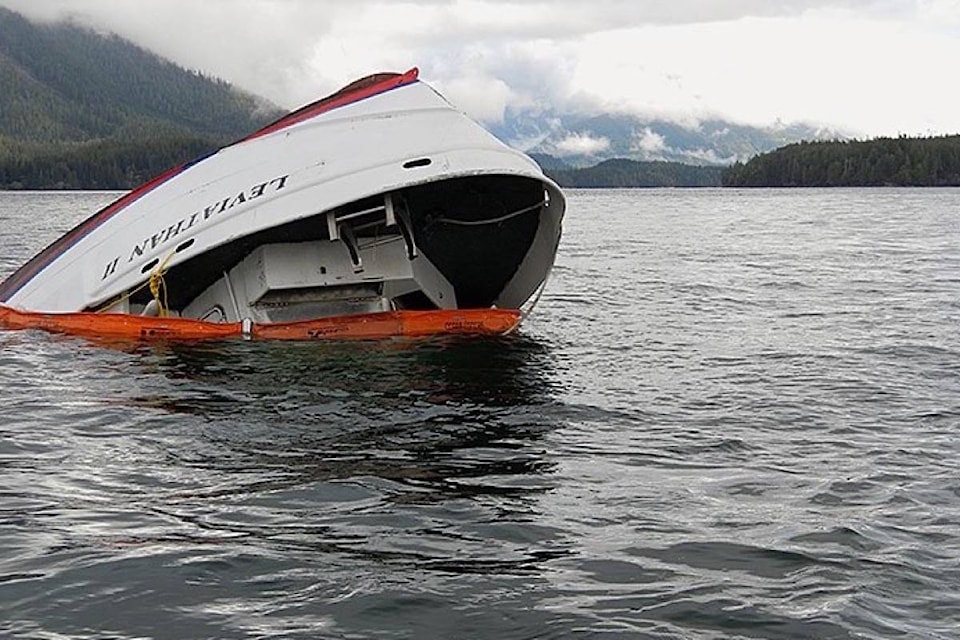The Transportation Safety Board is making three recommendations to improve passenger safety, following its investigation into the 2015 whale-watching boat sinking in Tofino that killed six people.
The Leviathan II, a 65-foot vessel owned by Jamie’s Whaling Station, capsized with 24 passengers and three crew members on board on Oct. 25, 2015. The recommendations focused on both reducing the risk of capsizing and improving the likelihood that passengers could survive a capsizing.
READ: Several confirmed dead in tragic whale watching disaster near Tofino
A huge wave struck the vessel at the starboard quarter, causing it to “pivot uncontrollably” with the wave, the report says. Board chair Kathy Fox said that neither vessel stability nor passengers crowding on one side of the vessel were to blame for its capsizing.
.@TSBCanada says that passengers crowding to one side of the Leviathan II was NOT a factor in its capsizing
— Kat (@katslepian) June 14, 2017
The board’s first recommendation is to require commercial passenger vessel operators on the west coast of Vancouver Island to identify areas and conditions where hazardous waves are likely to form, and adopt practical strategies to reduce the likelihood of an encounter.
The Leviathan II had taken its passengers to the Plover Reefs, a common area for whale watching expeditions off the west coast. However, the board found that Jamie’s Whaling Station “had not established guidelines to address the potential formation of breaking waves.”
As a result, since “the conditions were favourable for the formation of breaking waves,” the master of the ship was left to determine how to react to upcoming risks on his own.
Leviathan II heade to Ahous Bay to watch a pod of grey whales & then to Plover Reefs, so passengers could observe sea lions near #Tofino pic.twitter.com/lt1cZzVTgP
— Kat (@katslepian) June 14, 2017
In a second recommendation, the board said that the Department of Transport should require commercial passenger vessel operators to adopt explicit risk management processes, and develop comprehensive guidelines to be used by vessel operators and Transport Canada inspectors to assist them in the implementation and oversight of those processes. Those processes will vary depending on vessel size, type and conditions in the area.
Five British citizens and one Australian died when the Leviathan II capsized. Two of the survivors have launched a civil suit against the company and the RCMP case into the investigation remains open.
READ: Survivors of Tofino whale-watching incident sue tour company
The board also recommended that commercial passenger vessels should carry a position-indicating radio beacon if they leave sheltered waters, and that Transport Canada should guide the risk management process.
The report noted that it took 45 minutes before search and rescue became aware of the capsizing because the crew did not have time to issue a distress call nor did “the vessel have a means to automatically send a distress call.”
Ahousaht First Nation rescuers were first on scene to rescue the survivors. Their quick response earned them, as well as the community of Tofino, Medals of Good Citizenship in recognition of their bravery.
READ: Local First Nations receive rescue training
The passengers ingested sea water, oil and fuel as they struggled to stay above water after the boat tipped, the report continues. There is “no doubt” that those who were thrown into the water would have done better had they been wearing life-jackets, Fox said. She noted that traditional pre-inflated lifejackets can be dangerous in enclosed quarters and so vessel operators must ensure that the correct kind of flotation aids are supplied to passengers.
Jamie’s Whaling Station released a statement following the Transportation Safety Board report noting that the company has made efforts to improve safety since the 2015 tragedy. The company said it has increased the number and variety of flotation devices on board its vessels, re-instated position-indicating radio beacons and made improvements to the “extensive safety management practices.”
READ: Full response from Jamie’s Whaling Station on Leviathan II disaster report
The company’s owner, Jamie Bray, responded to the report in a video.
“Our thoughts continue to be with all the families impacted by this tragedy,” Bray said. “That day reminded all of us just how unpredictable the ocean can be and the tragedy of October 2015 will never fade from our minds.”
JAMIE’S WHALING STATION VIDEO RESPONSE:
LIVESTREAM OF TSB REPORT:
Like us on Facebook and follow us on Twitter.



